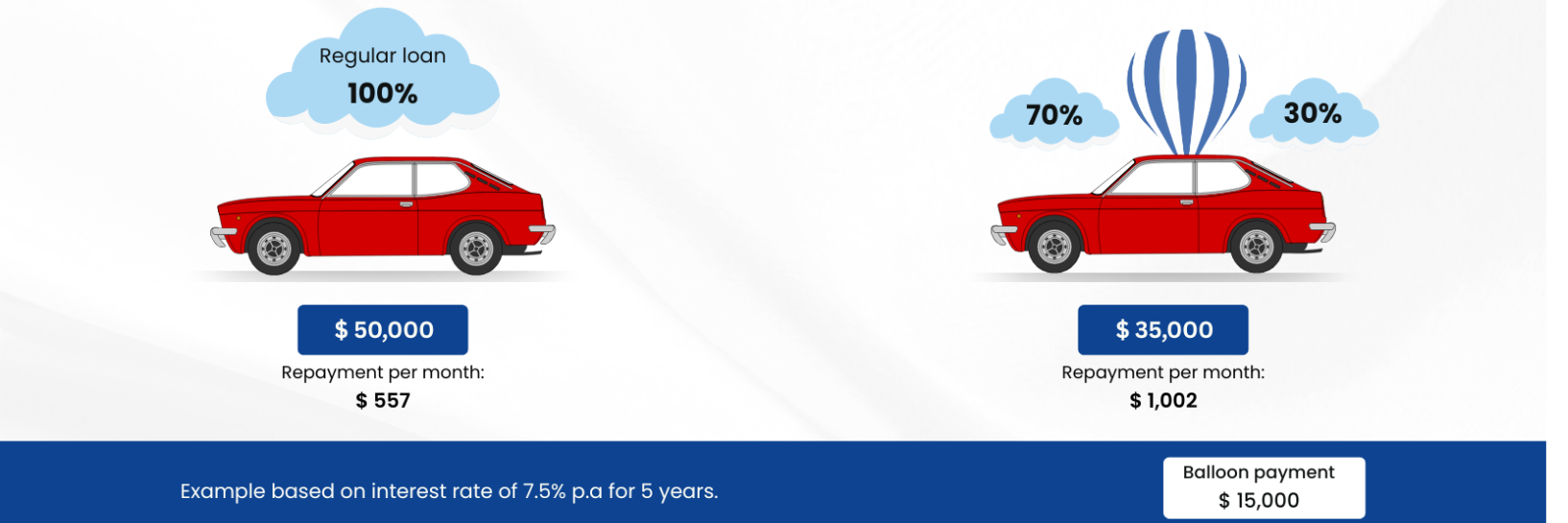Balloon payments in car loans: How they work and what to consider
Introduction
When financing a car, one option that may come up is a balloon payment. While this type of car loan may sound appealing due to lower monthly repayments, it's important to understand the long-term financial commitment involved.
A balloon payment is a large lump sum that’s paid at the end of the loan term, often amounting to a significant percentage of the car's value. In this post, we will explain how balloon payments are calculated, explore the pros and cons, and provide insight into key factors you should consider before choosing this option.
In this blog post, we explain how balloon payments are calculated, outline their potential benefits and risks, and highlight the key factors to consider before including one in your car finance agreement.
Key takeaways
- A balloon payment is a lump sum payable at the end of your car loan term.
- Balloon payments typically range from 15% to 50% of the car’s value.
- A balloon loan can help you afford a more expensive or newer car.
- Always compare lenders and understand all terms before signing a balloon loan.
What is a balloon payment car loan?
A balloon payment is a large lump sum that you agree to pay at the end of your car loan term. This payment typically ranges from 15% to 50% of the car's value. Unlike our personalised car loan options, where you repay both the principal and interest in equal monthly instalments, a balloon loan is structured differently.
With a balloon loan, you pay only a portion of the principal and interest throughout the loan term. The remaining balance, known as the balloon payment, is due at the end of the loan period. The size of the balloon payment is determined at the start of the loan based on the car’s expected value at the end of the term.
When you take out the loan, you and the lender will agree on the loan amount, repayment period, and interest rate. It's important to shop around for the best rates and terms, as they can vary between lenders.
How balloon payments in car loans work: Key differences from regular loans
A balloon car loan works in a similar way to a regular car loan. You agree with the lender on the loan amount, interest rate, and repayment term. What makes it different is that a portion of the loan is set aside to be paid at the end as a single lump sum.
This final amount, called the balloon payment, is usually a percentage of the total loan and may be limited by the lender’s policy.
Some lenders have strict conditions on how large the balloon payment can be and what interest rates apply. Others may offer more flexibility, especially if you have a good credit history.
Although you may be able to negotiate some parts of the loan, it is often best to choose an option that already matches your financial goals. Make sure the regular repayments are manageable and that you have a plan in place to cover the final amount.
Balloon finance on your mind?
Connect with our lending specialist today to see if it’s the right fit for you. A quick conversation could save you from costly mistakes and help you structure the loan the right way.
How are balloon payments calculated?
Let’s consider an example of how balloon payments are calculated:
Car Value: $50,000
Loan Term: 5 years
Balloon Payment: $15,000 (30% of the car's value)
Your monthly payments would be based on the reduced loan amount of $35,000, but the $15,000 balloon payment would be due at the end of the loan. Let’s compare the monthly repayment for a loan with and without a balloon payment:

| Balloon financing monthly repayment comparison | ||||
|---|---|---|---|---|
| With balloon payments | Without balloon payments | |||
| Vehicle Purchase Price | $50,000 | $50,000 | ||
| Loan Term | 5 years | 5 years | ||
| Ballon Payment (%) | 30% | N/A | ||
| Ballon Payment (%) | %50,000 * 30% = $15,000 | N/A | ||
| Loan Amount | $50,000 (-) $15,000 = $35,000 | $50,000 | ||
| Interest rate p.a | 7.50% | 7.50% | ||
| Monthly Repayment | $577 | $1,002 | ||
| Monthly savings | $1,002 (-) $557 = $445 | 0 | ||
Benefits of balloon payments in a car loan
The primary advantage of including a balloon payment in a car loan is that it makes your repayments lower. This structure benefits you in the following ways:
- Because repayments are lower, it eases the pressure on your monthly budget and makes it easier to manage other living expenses like rent, groceries, and utilities.
- You will have more cash available throughout the loan term, which can be used for saving, investing, or handling unexpected costs.
- This structure may allow you to afford a higher-value or newer vehicle that would be otherwise out of reach with standard repayment terms.
- If you plan to sell or upgrade your car in a few years, you can benefit from lower costs during ownership without worrying about the balloon until later.
- If you are using the vehicle for business, a balloon payment can help free up more funds during the loan term, supporting day-to-day operations or investment in other areas of your business.
Risks of balloon payments in car loans
While balloon payments can reduce your regular car loan repayments, there are several drawbacks you need to consider:
Higher loan Costs
While balloon payments reduce monthly repayments, they generally lead to higher total loan costs. This is because the balloon amount remains unpaid until the end of the term, and interest continues to apply on that remaining balance throughout the loan.
Large final payment
At the end of the loan, you are required to pay a lump sum, which can be thousands or even tens of thousands of dollars. Without proper planning, this amount can become difficult to manage and may create financial pressure.
Uncertainty with refinancing
If you cannot afford the final payment, you may consider refinancing. However, approval is not guaranteed. If your income, credit score, or financial situation has changed, you may not qualify for a new loan when you need it most.
Risk of depreciation and negative equity
Cars lose value over time. If the car is worth less than the balloon payment when it is due, you may owe more than the car is worth. This is a common problem for people who plan to sell the vehicle to cover the final payment.
Calculate your loan repayments in seconds
Use our loan repayment calculator to instantly check how much you may need to repay weekly, fortnightly, or monthly for your next loan.
Options for managing your balloon payment in car loans
When your car loan reaches the end of its term, the deferred balloon payment becomes due. This is often a significant lump sum, sometimes thousands or even tens of thousands of dollars, so it's important to plan ahead. You generally have three main ways to manage this final amount:
1. Pay the balloon payment in full
If you have enough savings set aside, the simplest option is to pay the balloon amount in one full payment. This clears your loan and gives you full ownership of the vehicle with no further financial obligations.
2. Trade In the vehicle and start a new loan or lease
If you are ready for a new car, you can trade in your current vehicle and apply its trade-in value toward a new purchase. This trade-in process can help offset or completely cover the balloon amount.
You would then:- Begin a new car loan or lease agreement
- Possibly include another balloon payment in the new finance structure
This is the best option for people who upgrade cars regularly and do not want to keep the same vehicle for the long term. However, make sure the trade-in value of your current car is enough to cover the balloon; otherwise, you will need to pay the difference.
3. Refinance the balloon amount
If you want to keep the car but cannot afford to pay the balloon amount upfront, refinancing allows you to convert the balloon into a new loan. This option spreads the final amount over another 1 to 5 years with monthly repayments.
How does it work?- You apply for a new loan for the balloon amount
- The interest rate is based on your current credit profile
- You can choose whether or not to include a new balloon payment in the refinanced loan
This option works best for people who are happy with their vehicle and want to avoid a large lump-sum payment. Just keep in mind that extending the loan will increase your total interest paid.
It is recommended to start planning a few months before your balloon payment is due.
This allows you to:- Review your current financial position and decide what you can afford
- Compare refinancing options and check interest rates based on your credit profile
- Explore trade-in values if you are considering a new car
- Prepare your next steps early to avoid last-minute decisions or financial stress
Is a balloon payment right for you? Key considerations before committing
Before deciding if a balloon payment suits your situation, it’s important to weigh these key factors to make a well-informed and feasible decision.
Future income stability
Think about whether your income is likely to remain steady by the time the balloon payment is due. If you anticipate a job change, reduced hours, or a break from work, the final lump sum could create pressure.
Vehicle ownership plan
Are you planning to keep the car long term or change it within a few years? Balloon loans work better if you intend to trade in the vehicle before the balloon amount becomes payable.
Refinancing access uncertainty
If your plan is to refinance the balloon payment, remember that this depends on market conditions and your financial profile at the time. There’s no guarantee you’ll qualify for another loan in future.
Cash flow clashes
Consider any major financial commitments that may arise near the end of your loan term. Expenses such as a home deposit, renovation, or family event could affect your ability to cover the balloon.
Lender terms awareness
Check whether your lender allows early repayments or refinancing without penalty. Some may have rigid terms that limit your flexibility when circumstances change.
Bottom Line
Choosing a balloon payment is just one of several key decisions when financing your next car. It offers flexibility in how your loan is structured and may be suitable depending on how long you plan to keep the vehicle and what your financial situation looks like at the end of the term.
At ZedPlus, our lending specialists take the time to understand your needs and recommend car loan options that match your goals. With access to a broad range of lenders, we provide competitive and flexible finance solutions that are tailored to your circumstances.
Whether you are buying your first car or upgrading, we are here to guide you through every stage of the process. From selecting the right loan structure to handling your application, we ensure the process is simple and transparent.
Book a call with one of our lending experts today and take the next step in your car finance journey.
Ballon payment car loan FAQs
Is a balloon payment on a car loan a good idea?
A balloon payment on a car loan can be a good idea if you need lower monthly payments and can handle the lump-sum payment at the end of the loan term. It’s important to assess your financial situation and long-term plans, including whether you will be able to afford the final payment or if you will need to refinance.
What is the major problem with balloon payments?
The main issue with balloon payments is the large lump sum due at the end of the loan. If you don't plan ahead or are unable to refinance, this payment could become a significant financial burden. Additionally, balloon payments may result in higher overall interest costs compared to regular loans.
What is the 50% rule on car finance?
The 50% rule in car finance generally refers to the percentage of the car’s value that can be paid off in a balloon payment. Typically, a balloon payment can range from 15% to 50% of the car’s price, depending on the terms of the loan.
What is the 50/30/20 rule for car payments?
The 50/30/20 rule is a budgeting guideline that helps you manage your finances. For car payments:
- 50% of your income should go toward necessities (housing, utilities, etc.).
- 30% should be for discretionary spending (entertainment, shopping).
- 20% should be allocated for savings and debt repayment, including any balloon payments on a car loan.
What credit score do I need to get a $50,000 car loan?
To secure a $50,000 car loan, most lenders require a minimum credit score of 650. However, a higher score of 700 or more can help you secure better interest rates and loan terms.



